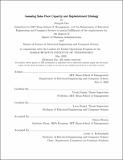Assessing sales floor capacity and replenishment strategy
Author(s)
Das, Durgesh.
Download1191622713-MIT.pdf (5.477Mb)
Other Contributors
Sloan School of Management.
Massachusetts Institute of Technology. Department of Electrical Engineering and Computer Science.
Leaders for Manufacturing Program.
Advisor
Vivek Farias and Luca Daniel.
Terms of use
Metadata
Show full item recordAbstract
Target stores (and the upstream supply chain) have been traditionally designed for a predominantly brick and mortar business, fed by a push supply chain model. With the growing need for omnichannel sales fulαllment, supply chain engineering has become signiαcantly more complex. Based on the traditional model, ideal inventory levels in the store, as well as the upstream replenishment logic are derived with a focus on the in-store customer experience. Two pain points of this design are: 1. The long tail, in the product assortment distribution, of low-velocity items carried in all stores. 2. Inβexibility to use dynamic unit of measure (deαned as the type of packaging an item is transported in - can be an each, case pack, pallet), because merchants set the unit of measure system-wide thus overpack items are overpack in all stores regardless of sales volume. Both are backroom space and labor intensive. In anticipation of stores becoming shipping hubs in the future and the need to fulαll Target's long-term planning, we will take a data driven approach to determine optimal sales βoor item capacity in order to αnd eciencies in upstream sortation leading to cost reductions in downstream, without impacting critical functions including customer reception and experience in store and demand signal fulαllment.
Description
Thesis: M.B.A., Massachusetts Institute of Technology, Sloan School of Management, in conjunction with the Leaders for Manufacturing Program at MIT, May, 2020 Thesis: S.M., Massachusetts Institute of Technology, Department of Electrical Engineering and Computer Science, in conjunction with the Leaders for Manufacturing Program at MIT, 2020 Cataloged from the official PDF of thesis. "May 2020." Includes bibliographical references (pages 68-69).
Date issued
2020Department
Sloan School of Management; Massachusetts Institute of Technology. Department of Electrical Engineering and Computer Science; Leaders for Manufacturing ProgramPublisher
Massachusetts Institute of Technology
Keywords
Sloan School of Management., Electrical Engineering and Computer Science., Leaders for Manufacturing Program.